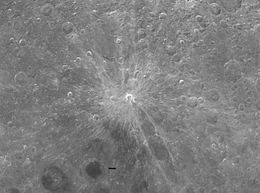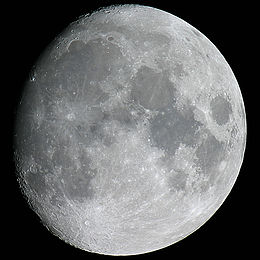Ray system

A radiation system is in the astronomy a grouping striking since rays designated strips radially about a center located in the typically craters , a so-called beam craters are disposed.
description
Radiation systems are mainly known from the moon . The jets look like traces of spray and are mostly brighter than their surroundings. They are most noticeable when the sun is high and the viewing direction is just as vertical - from the earth at a full moon - when, in contrast, the outlines of the craters and other details are blurred in the light. When illuminated from the side, the radial stripes do not cast any shadows , so they have no relief . The rays are up to several kilometers wide and extend straight or curved up to many hundreds of kilometers over mountains and valleys. They pass through highlands as well as lowlands often without deviations or interruptions and generally thin out more or less gradually in their brightness with increasing distance from the central crater.
The appearance of the rays is explained by a composition of pulverized material that was thrown out by a large impact when the central crater was formed; or also with glass-like particles, to which the rock, which was evaporated by the great energy of the impact, had solidified again and which are responsible for the strong reflectivity .

The relatively few and mostly central radiation craters usually have a similarly high albedo and are of a very regular shape. The overall structure thus gives the impression of a fresh appearance and thus a relatively young age. It is assumed that the light-colored substance reflects the sunlight more strongly the shorter it has been exposed to the particles of the solar wind , the cosmic particle radiation and the hail of micrometeorites since its formation . The small number of large radiation systems is attributed to a decreasing frequency of large impacts. Most of the lunar craters do not have radial stripes.
Many of the rays, which at first glance appear to be continuous, have a multiple changing intensity. Sometimes they also stop temporarily and consist of a series of individual stripes that are only roughly aligned against the central crater. Overall, the center of the radiation does not always coincide with the center of the impact crater . The rays only start at some distance from the crater wall , which is therefore separated from the formation circle by a generally darker ring zone. Some rays contain larger blocks of rock and run over small secondary craters from which rays emanate. Some small craters only have a bright halo around their wall.
The largest radiation system on the moon has the Tycho crater, 85 kilometers in diameter . Its bright radial stripes reach up to a distance of about 1,800 kilometers. Other known ray craters on the moon are Copernicus , Kepler , Aristarchus and Proclus .
Radiation craters have also been found on other bodies in the solar system , such as on the externally lunar-like planet Mercury as well as under the great satellites of Jupiter on Europe , Ganymede and Callisto . On celestial bodies with a dense atmosphere such as Venus or with one as thin as Mars , such radial structures are extinguished much faster by erosion .
See also
literature
- Rolf Sauermost (Ed.): Lexicon of Astronomy. In 2 volumes. Herder, Freiburg 1989f. ISBN 3-451-21632-9
- Jacqueline Mitton: Astronomy from A to Z. Franckh-Kosmos , Stuttgart 1995. ISBN 3-440-07007-7